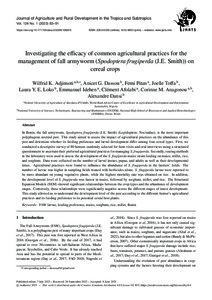| dc.date.accessioned | 2023-07-10T13:42:22Z | |
| dc.date.available | 2023-07-10T13:42:22Z | |
| dc.date.issued | 2023-07 | |
| dc.identifier | doi:10.17170/kobra-202306128205 | |
| dc.identifier.uri | http://hdl.handle.net/123456789/14885 | |
| dc.language.iso | eng | |
| dc.rights | Namensnennung 4.0 International | * |
| dc.rights.uri | http://creativecommons.org/licenses/by/4.0/ | * |
| dc.subject | FAW larvae | eng |
| dc.subject | feeding preference | eng |
| dc.subject | maize | eng |
| dc.subject | sorghum | eng |
| dc.subject | rice | eng |
| dc.subject | millet | eng |
| dc.subject | Benin | eng |
| dc.subject.ddc | 580 | |
| dc.subject.ddc | 590 | |
| dc.subject.ddc | 630 | |
| dc.title | Investigating the efficacy of common agricultural practices for the management of fall armyworm (Spodoptera frugiperda (J.E. Smith)) on cereal crops | eng |
| dc.type | Aufsatz | |
| dcterms.abstract | In Benin, the fall armyworm, Spodoptera frugiperda (J.E. Smith) (Lepidoptera: Noctuidae), is the most important polyphagous noctuid pest. This study aimed to assess the impact of agricultural practices on the abundance of this pest and determine whether its feeding preference and larval development differ among four cereal types. First, we conducted a descriptive survey of 80 farmers randomly selected for farm visits and oral interviews using a structured questionnaire to ascertain their preferred agricultural practices for managing S. frugiperda. Secondly, rearing methods in the laboratory were used to assess the development of the S. frugiperda maize strain feeding on maize, millet, rice, and sorghum. Data were collected on the number of larval instars, pupae, and adults as well as their developmental times. Agricultural practices were found to influence the abundance of S. frugiperda in the farmers’ fields. The number of larvae was higher in sampling fields treated with herbicides alone. S. frugiperda larvae were reported to be more abundant on young vegetative plants, while the highest mortality rate was obtained on rice. In addition, the development level of S. frugiperda was fastest in maize, followed by sorghum, millet, and rice. The Structural Equation Models (SEM) showed significant relationships between the crop types and the abundance of development stages. Conversely, these relationships were significantly negative across the different stages of insect development. This study allowed us to understand the development level of the pest according to the different farmer’s agricultural practices and its feeding preference to its potential cereal host plants. | eng |
| dcterms.accessRights | open access | |
| dcterms.creator | Adjimoti, Wilfrid K. | |
| dcterms.creator | Dassou, Anicet Gbèblonoudo | |
| dcterms.creator | Pitan, Femi | |
| dcterms.creator | Toffa, Joelle | |
| dcterms.creator | Loko, Laura Y. Estelle | |
| dcterms.creator | Idehen, Emmanuel | |
| dcterms.creator | Afolabi, Clément | |
| dcterms.creator | Anagonou, Corinne M. | |
| dcterms.creator | Dansi, Alexandre | |
| dcterms.extent | 83-91 | |
| dc.subject.swd | Benin | ger |
| dc.subject.swd | Spodoptera frugiperda | ger |
| dc.subject.swd | Getreideanbau | ger |
| dc.subject.swd | Schädlingsbekämpfung | ger |
| dc.type.version | publishedVersion | |
| dcterms.source.identifier | eissn:2363-6033 | |
| dcterms.source.issue | No. 1 | |
| dcterms.source.journal | Journal of Agriculture and Rural Development in the Tropics and Subtropics (JARTS) | eng |
| dcterms.source.volume | Vol. 124 | |
| kup.iskup | false | |
| ubks.epflicht | true | |


